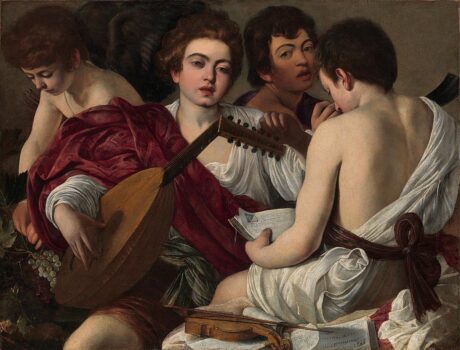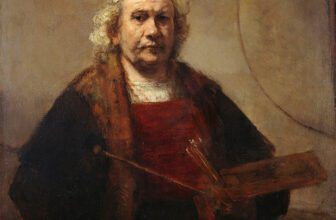The Musicians Caravaggio: Analysis and Meaning
Few works in art history capture the delicate intersection of music, youth, sensuality, and allegory as compellingly as Caravaggio’s The Musicians. Painted around 1595–1596, during the young artist’s rise in Rome, the painting offers not only a glimpse into his early style but also a profound meditation on art, love, and the human condition. Today, housed in the Metropolitan Museum of Art in New York, the work remains one of Caravaggio’s most discussed and analyzed masterpieces, embodying both his naturalistic genius and his subtle allegorical depth.
This article will take you on a journey through the origins of the painting, how it was created, what it represents, the symbolism embedded within, and its place in Caravaggio’s career and the wider tradition of Renaissance and Baroque art.
Caravaggio in Rome
Michelangelo Merisi da Caravaggio (1571–1610) arrived in Rome in the early 1590s, a young painter with enormous talent but little money or recognition. At that time, Rome was a vibrant hub for artists, patrons, and intellectuals, where art was expected to inspire devotion, stimulate thought, and delight the senses.
Caravaggio’s early works were mostly small-scale still lifes, genre scenes, and half-length figures of musicians, cardsharps, and fortune tellers. These subjects catered to the taste of private patrons rather than public churches. The Musicians belongs to this formative period, when the artist was experimenting with naturalism, chiaroscuro, and allegory.
The painting was commissioned by Cardinal Francesco Maria Del Monte, Caravaggio’s first great patron and protector. Del Monte was a cultured man with a keen interest in music, theater, and the arts, and he maintained a private household where musicians and artists mingled. It is no coincidence that Caravaggio chose music as his subject for this work, music was not only a pastime but also a symbol of harmony, love, and divine inspiration.
Description of the Painting
The Musicians shows four young men, crowded tightly together, dressed in contemporary costumes resembling theatrical attire. At the center is a lute player, intent on his music. To his left, another youth reads from a musical score, while to the right, another boy appears to adjust his instrument. In the background, Cupid, the god of love, leans forward with a quiver of arrows slung over his shoulder, holding a bunch of grapes.
The arrangement is intimate and compressed. The figures are so close to one another that they seem almost pressed into the picture plane, evoking both a sense of immediacy and claustrophobia. The lighting is soft yet focused, highlighting the pale skin of the boys, the sheen of their costumes, and the gleam of the instruments.
The painting is oil on canvas, measuring 36 ¼ × 46 5/8 inches (92 × 118.5 cm). Its current location is the Metropolitan Museum of Art, New York, where it is part of the European Paintings collection.
How The Musicians Was Painted
Caravaggio’s technique was revolutionary for his time. Rejecting the idealized forms of Mannerism, he painted directly from life, often using friends, models, and acquaintances as sitters. For The Musicians, scholars believe he used young boys from Cardinal Del Monte’s household as models, including Mario Minniti, Caravaggio’s close companion and frequent model.
Unlike traditional artists who sketched elaborate preparatory drawings, Caravaggio worked directly onto the canvas. Infrared reflectography and X-rays reveal minimal underdrawing, he preferred to paint what he saw in front of him, adjusting as he went. This contributed to the striking realism of his figures.
The lighting in The Musicians is also significant. Unlike his later dramatic chiaroscuro, here the light is softer, enveloping the figures in a warm glow that creates volume and sensuality. The textures of skin, fabric, and fruit are rendered with almost tangible precision, showcasing his extraordinary observational skill.
What The Musicians Represents
At its most basic level, The Musicians represents a group of youths engaged in making music. But beneath this surface lies a wealth of symbolism and layered meaning.
Allegory of Music and Love
The inclusion of Cupid in the background suggests that the painting is not merely a genre scene but an allegory. In Renaissance thought, music was often linked to love, as both were capable of stirring the emotions and harmonizing the soul. Cupid’s presence, with his arrows and grapes, reinforces the idea that music and love are intertwined forces of passion and pleasure.
A Reflection of Youth and Sensuality
The figures are portrayed with a delicate sensuality, their soft features, parted lips, and languid expressions evoke an atmosphere of longing and intimacy. Many scholars have interpreted the painting as a meditation on homoerotic desire, particularly given the close physical proximity of the figures and the presence of Cupid, a symbol of erotic love.
Ephemeral Nature of Pleasure
The grapes held by Cupid may also serve as a vanitas symbol, reminding viewers of the fleeting nature of sensual delights. Just as grapes wither, so too do youth, beauty, and the pleasures of music and love.
Symbolism and Meaning
Caravaggio, like many Renaissance and Baroque artists, infused his paintings with symbolic meaning. Here are some of the key symbols in The Musicians:
Cupid: Represents love in all its forms, physical, spiritual, and divine. His inclusion signals that the painting is more than a simple depiction of musicians; it is an allegory of love and harmony.
Grapes: A symbol of Bacchus, the god of wine, grapes evoke pleasure, intoxication, and the fleeting joys of life. They may also allude to the Eucharist, suggesting a spiritual layer to the allegory.
Musical Instruments: The lute, cornetto, and violin symbolize harmony, art, and the power of music to unite souls. In Renaissance iconography, music was often a metaphor for cosmic order.
Costumes: The theatrical attire hints at performance and role-playing, perhaps underscoring the idea that love and art alike involve masks, illusions, and staged emotions.
Together, these elements suggest a rich allegory about the interplay between art, love, pleasure, and mortality.
What Is Happening in the The Musicians Painting?
At first glance, the painting shows a rehearsal or performance. The central figure plucks a lute, accompanied by his companions. One boy studies the music, another tunes his instrument, and Cupid observes, holding grapes as if offering a reward or temptation.
But the scene is also psychological: the expressions of the youths are introspective, almost melancholic. They seem less engaged in music-making than lost in thought or desire. The crowded composition and intimate gestures create an atmosphere of sensual tension, suggesting that what is “happening” is less about music itself and more about the emotions and desires it stirs.
The Type of Art: Genre, Allegory, and Baroque
The Musicians is a hybrid of several art types:
Genre Scene: On the surface, it depicts everyday life, a group of young musicians rehearsing.
Allegory: With Cupid’s presence, it transcends mere genre to symbolize love, harmony, and the ephemeral nature of pleasure.
Early Baroque: While painted at the cusp of the Baroque, the painting shows Caravaggio’s naturalism and dramatic lighting, key elements of Baroque art. However, its mood is softer and more lyrical than his later works like The Calling of Saint Matthew or Judith Beheading Holofernes.
Thus, The Musicians represents a transitional moment in Caravaggio’s style, balancing Renaissance ideals of harmony with Baroque realism and emotional intensity.
Symbolic Interpretations Across Time
Art historians have debated the meaning of The Musicians for centuries. Some interpretations include:
Neo-Platonic Allegory: Music symbolizes the harmony of the cosmos and the soul, while Cupid represents divine love guiding human passions.
Homoerotic Reading: The sensual portrayal of the youths and their intimate arrangement suggest an exploration of male beauty and desire, possibly reflecting the atmosphere of Cardinal Del Monte’s circle.
Vanitas Theme: The grapes and ephemeral music highlight the transience of earthly pleasures, aligning with the vanitas tradition of reminding viewers of mortality.
Each interpretation enriches our understanding of the work, showing how Caravaggio layered meaning in his art.
The Musicians Painting Reception and Legacy
When Caravaggio painted The Musicians, he was still establishing himself in Rome. The work appealed to the refined tastes of Del Monte and his circle, who appreciated allegorical subjects infused with sensuality and intellect.
Over time, the painting became recognized as a key example of Caravaggio’s early genius. It demonstrates his ability to merge realism with allegory, to depict the human figure with startling naturalism while imbuing it with symbolic resonance.
Today, the painting continues to fascinate viewers for its beauty, ambiguity, and layered meaning. It bridges the gap between Renaissance ideals and Baroque drama, marking a pivotal step in Caravaggio’s artistic evolution.
The Musicians Painting Location Today
The Musicians is currently housed in the Metropolitan Museum of Art in New York. It is part of the museum’s permanent collection, a prized example of Caravaggio’s early work. Visitors can see it alongside other masterpieces of European painting, where it continues to inspire debate, admiration, and interpretation.
Caravaggio’s The Musicians is far more than a charming image of youthful performers. It is a complex allegory of music, love, sensuality, and transience. Painted with extraordinary naturalism and psychological depth, it reflects both the intellectual climate of Cardinal Del Monte’s household and Caravaggio’s burgeoning genius as an artist.
In its interplay of sight, sound, and symbolism, the painting invites viewers to reflect on the harmonies and dissonances of human life, on love’s pleasures, art’s beauty, and the inevitability of passing time. That is why, more than four centuries after its creation, The Musicians still captivates the imagination and remains one of Caravaggio’s most meaningful works.




